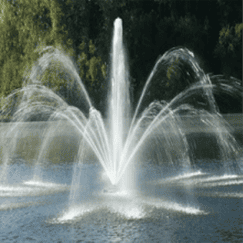Pond Aeration, the 4 Kinds
Pond Aeration, Why it is Necessary
Pond aeration is necessary because ponds become stratified over time and with the switching of seasons. This means the water forms layers, typically with warmer water at the top and cooler water at the bottom. With stratification, anaerobic bacteria multiply too quickly, resulting in sediment build up at the bottom of the pond, which releases noxious gases that smell and create harmful algae blooms, darkening your water and making it murky. Aeration mixes the oxygen in the water, thus destratifying it and making the layers blend together. The buildup of bottom muck is decreased, along with decreases in algae and increases in fish health because oxygen is spread throughout the pond.
Ponds Are Aerated from Top or from Bottom
To decide which is the best way to aerate, from top or from bottom, you need to determine the average depth of your pond. Average depth can be determined by taking multiple measurements of pond depth at different points in your pond, most easily done in a boat. Simply drop a weighted line into you pond at different points in your pond and measure how far down the bottom is. If your pond is deeper than seven feet, on average, then you will need bottom aeration to properly oxygenate the water. If your pond is shallower, then surface aeration is the best bet.
Three Kinds of Surface Aerators
A surface aerator, as the name implies, works from the surface. A pump is attached beneath a float and water is emitted at the surface. This results in oxygen transfer as the water circulates in the pond.
Note, however, that there are three kinds of surface aerators.
Pond Fountains—Decorative
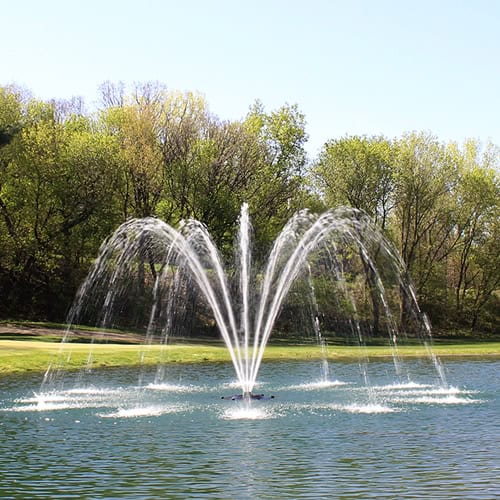
If a nozzle is inserted on top of the float, then you have a decorative pond fountain. This kind of surface aerator provides the most dramatic display and kits usually include multiple nozzles for changing your displays when desired. Note that because these fountain pumps use impellers and because nozzles are used they aerate less effectively than the other surface aerators. The smaller the holes in the nozzle, the less aeration will occur, as less water will flow out the holes than if they are large. In general, really tall fountains require smaller holes in the nozzle to reach their heights, thus flow is restricted and less water is being circulated, resulting in less oxygen transfer. As a general rule of thumb, Kasco floating pond fountains use larger holes in their nozzles and aerate better. We sell three brands of decorative fountains, Kasco Marine, which aerates the most; Scott Fountains, which produce huge displays; and Fountain Tech, which aerate quite a bit for a budget line of fountains.
Pond Fountains—Aerating Fountains
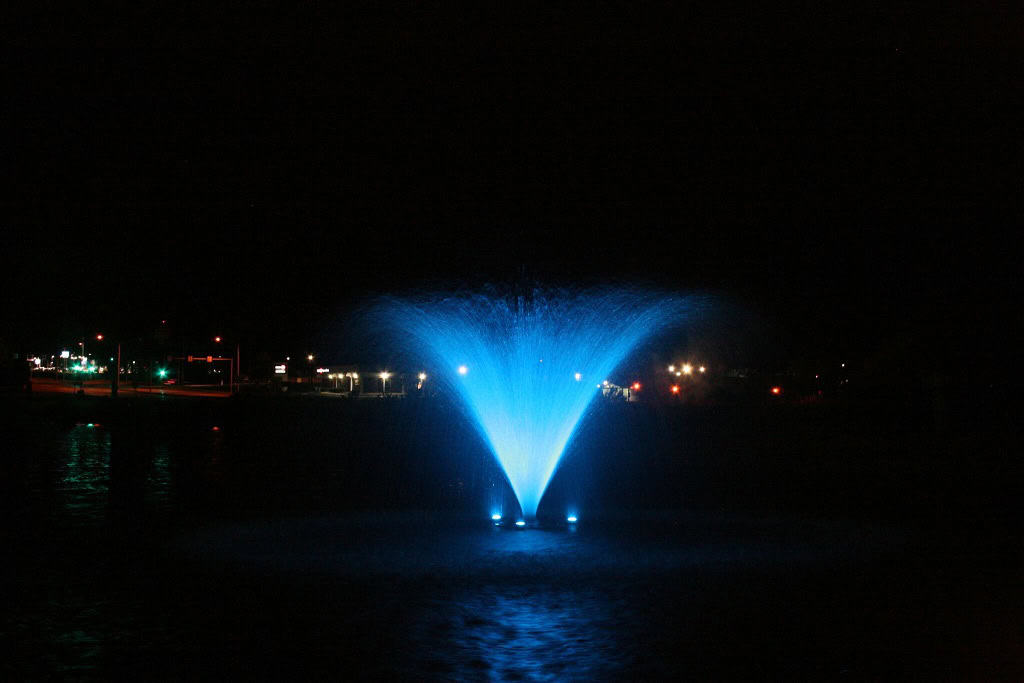
Pumps for aerating fountains use propellers instead of impellers and the propeller creates the pattern, which is limited to a V-shaped pattern. Think of these as a large hole through which a propeller pushes water; thus more aeration occurs than with decorative fountains. The pattern is elegant in its classic simplicity, but these fountains do not provide very much height. We sell aerating fountains made by Kasco as well as Scott.
Pure Surface Aerators
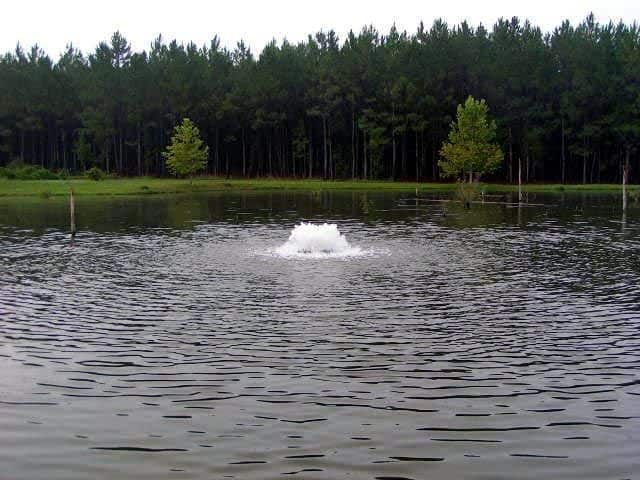
Pure surface aerators don’t include a nozzle at all and their “display” is limited to large bubbles on the surface of the water. Water is drawn from fairly deep into the pond and brought to the surface. There is considerable agitation and mixing, reducing stratification in the pond. If lights are added, they can still be pretty at night as the light reflects off the large bubbles. We sell aerators made by Kasco Marine.
Despite their considerable aid in aerating ponds, surface aerators, even pure surface aerators, do not reach down deeply enough for ponds over seven feet in depth. For deep ponds, it is best to use a bottom aerator.
Bottom Aeration
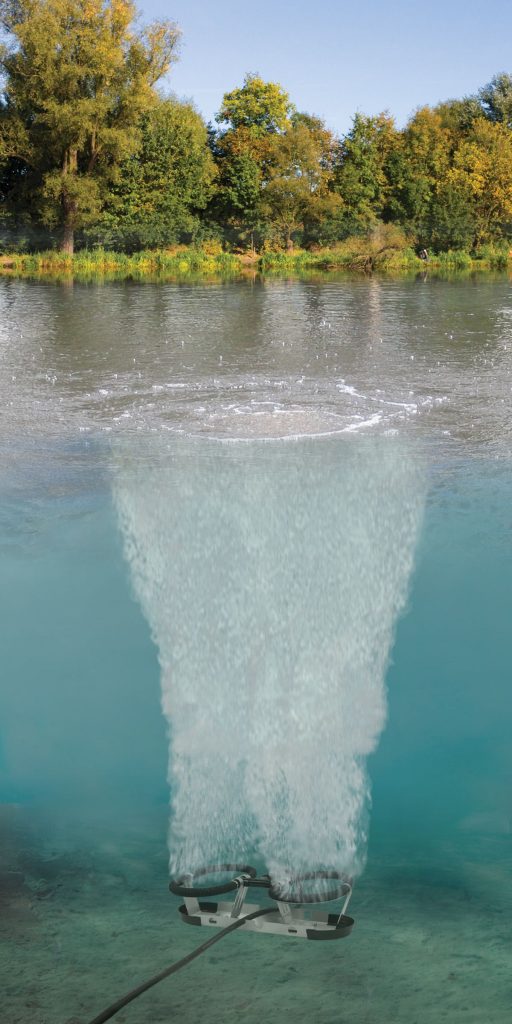
Bottom aeration uses a diffuser system to aerate your pond from the bottom up. A compressor is housed at the shoreline, either in housing sold by the manufacturer or housing created by you to protect the compressor from the elements of weather. Note: compressors must be housed in way that allows them to keep cool through a vent system of some kind. This compressor is attached to weighted tubing that goes from the housing to the bottom of the pond, supplying air to a diffuser or set of diffusers sitting at the bottom of the pond. Air bubbles rise from the bottom of the pond via the diffuser(s), mixing and oxygenating the water on the air bubbles’ way to the top. Compressors are usually fairly quiet these days and for most Kasco bottom aeration units you will only need a ¼ horsepower compressor, which use very little electricity. Bottom aeration is intended to be used 24 hours a day.
How to Calculate Pond Size
For surface aeration, you only need to know the surface area of pond to calculate pond size. Thus, you only need to know length x width for rectangular ponds.
Thus, if your pond is 120’ long by 40’ wide, your pond size= 4800 square feet.
1 acre= 43,560 square feet
4800 divided by 43,560= .11 acres in size.
For circular ponds, you will need to calculate the pond’s radius (half the width).
Then multiply X radius times X radius by 3.14 (pi from you math days)
If your pond is a 200’ x 200’ circle, then:
100 x 100 x 3.14= 31,400 sq feet
31,400 divided by 43,560= .72 acre pond
Measurements need only by approximate.
For bottom aeration, you will need to know not surface acreage but acre feet in your pond.
You will need to determine length x width x average depth of the pond.
But to easily calculate pond size, whether you want to determine surface acres, acre feet, or total gallons of water in your pond, we recommend you use our pond size calculator! You can also find out electrical costs if you know what your utility company charges for KW hour.
Fountain Mountain, Inc was created in 1999, and Fountain Tech was created as its line of fountain pumps and floating fountains in 2003. We aim to be reliable and supportive of our customers’ needs.


